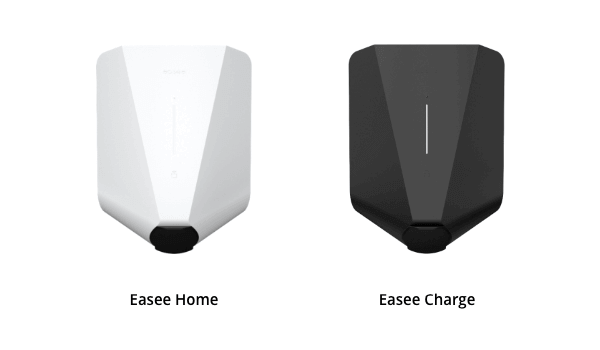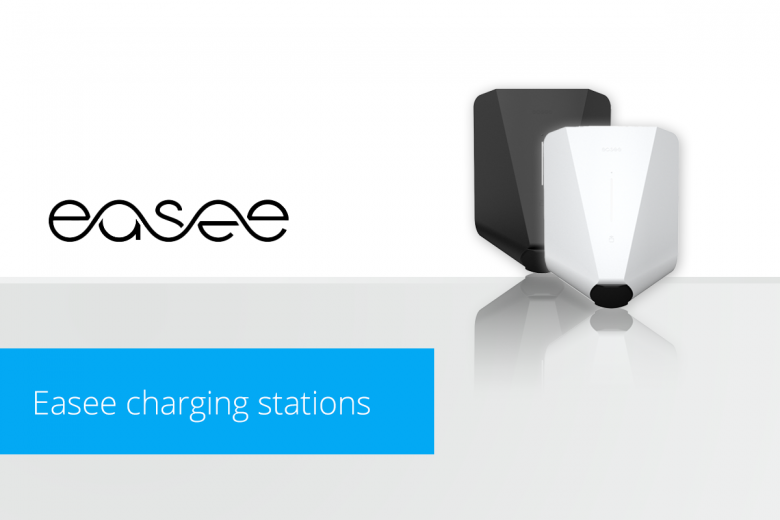Easee: Charging stations for private and commercial applications
Compact, elegant and much more – Easee charging stations come from Norway and are rich in technical details. Below we present you our newcomers in more detail.
Easee charging stations are designed for both private and commercial sectors and are therefore called Easee Home and Easee Charge respectively. Both versions can charge on 1-phase and 3-phase power and support charging up to 22 kW. With the Home variant, you can have up to 3 charging stations on one fuse. With the commercial Easee, up to 101. All connected vehicles can be charged at the same time and the available power is automatically distributed between the wallboxes.
Connection and security
The charging stations can be connected to the internet via 4G or via WIFI. Easee’s own cloud solution transfers software updates to the devices. The wallbox can be controlled manually and via the Easee app, which shows, for example, how fully charged the vehicle battery already is and the power distribution on each phase. For more security and to control the access, users can rely on RFID key fobs and start the charging process. It is also possible to lock the charging cable to the wallbox.

Design in a single box
The design is simple but elegant. The Easee charging stations are about 69 % smaller than comparable devices and weigh 1.5 kg. The front cover of the wallboxes is available in 5 different colours. You can choose to change the colour.
Once you have installed it, the Easee charging station is guaranteed by a 3-year warranty.
| Category | Home | Charge | |
|---|---|---|---|
| Charging connection | Socket | Yes | No |
| Charging points | 1 | 1 | |
| AC phases | 1 | Yes | Yes |
| 3 | Yes | Yes | |
| Max. charging power | 22 kW | 22 kW | |
| Number of wallboxes per fuse | 3 | 101 | |
| Installation sector | private | Yes | Yes |
| commercial | – | Yes | |
| Earth fault circuit breaker | One additional type A circuit breaker per fuse | One additional type A circuit breaker per fuse | |
| Access control | RFID | Yes | Yes |
| Energy meter | Simple meter | Simple meter | |
| PV surplus charging | – | – | |
| OCPP | 1.6 | Yes | Yes |
Table: Easee Home and Charge and their features
Installation and setup of the Easee charging stations
Take the charging station and the tool out of the packaging, which is no bigger than a shoebox. Open the cover by inserting the supplied tool into the openings. Pull the tool until the front cover comes loose. The main unit (Chargeberry) will also disconnect. Use the screws and plugs from the installation kit to fix the backplate to a wall. You can connect the AC cable from above, behind or below. It should have 3 outer conductors. Then follow the printed instructions to connect the charging station to the TN network.
Now it’s time for configuration. Connect the smartphone to the Wi-Fi of the main unit. Search for the IP address in the browser, enter the PIN code and type in the requested data. Replace the front cover and screw in the locking screw to secure the front cover.
Video: Installation Easee Home
About the company
Easee was launched in 2018, when 3 friends decided to follow in the footsteps of 3 entrepreneurs and set up a company which develops and manufactures its own products in Norway. Each Easee’s solution is intended to promote the sustainability of the ecosystem. Easee wants to be sustainable and resources sparingly.
Conclusion
Easee charging station is an intelligent and easy-to-use wallbox with a compact and appealing design. Especially for the private sector, Easee wallbox Home is perfectly designed with advanced technical features such as the automatic phase switching. With the Easee app, users can choose and control different configurations. Unfortunately, the Charge variant is not equipped with an MID meter.
However, Easee gets another plus point for its price-performance ratio.
With its green packaging and green production process, Easee is very sustainably oriented.
Summary
- Easee offers charging stations for the private and commercial sector with up to 22 kW
- Installation and setup work via Easee app
- Easee manufactures in Norway and was founded in 2018 by 3 entrepreneurs


